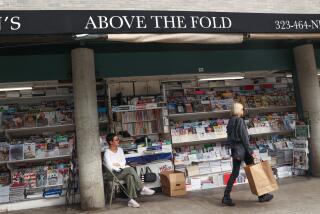What iTunes can teach newspapers
- Share via
I was standing recently before a classroom full of fresh-faced journalism students at a local high school. As I usually do at such things, I opened by asking for a show of hands from all those planning newspaper careers.
Crickets.
“Nobody?” I asked.
A couple of students tentatively raised their hands, mostly, I gathered, out of a sense of politeness.
Why should I have expected anything different? The newspaper industry is rapidly disintegrating. On Friday, Denver’s Rocky Mountain News was set to publish its last edition -- just two months shy of the paper’s 150th anniversary.
Earlier in the week, the San Francisco Chronicle, Northern California’s largest newspaper, said it planned to make “significant” cutbacks to its already spartan staff and could soon close unless a buyer is found.
Meanwhile, Variety reported that Rupert Murdoch may be interested in making plays for both the New York Times and the Los Angeles Times, which I suppose should be encouraging but somehow isn’t.
Yes, he owns the Wall Street Journal and hasn’t made a botch of it. But he also owns the New York Post, which says a little bit about the candy coating he prefers for his metro news coverage.
Don’t get me wrong. This isn’t another whiny rant from an employee of a dying industry. If anything, I believe there’s never been a bigger or more robust global market for the product we sell -- information.
The problem is that newspapers have proved themselves to be pretty pathetic at selling their output in a digital economy where information, as some are so fond of saying, “wants to be free.”
I see this first and foremost as a consumer issue, and as such it’s by all means fixable.
Let’s look at things in generic terms. On the sell side, we have companies that manufacture a quality product that’s easily differentiated from inferior goods.
On the buy side, we have consumers who have desired this product for centuries and will undoubtedly continue doing so for centuries to come (unless stupidity becomes a defining virtue).
So what’s the problem? It’s a distribution issue. What’s the best way to deliver this product to consumers?
OK, we all know where this is going. Newspapers shot themselves in the foot by giving away their content online, it’s too late to reverse course, yadda yadda yadda.
Steven A. Smith, former editor of the Spokesman-Review in Washington State, said in a blog post last week that “the pay-no-pay issue already has been resolved by consumers.”
“Readers will not pay for online news content provided by traditional mass-market news organizations,” he said. “For traditional newspapers, the genie is out of the bottle. No organization can hold on to its information long enough to make it a viable commercial commodity in the digital world.
“Once published anywhere or in any way, the information is out there, for free, for everyone.”
Is it? After the Chronicle -- where I worked for eight years -- announced that a “for sale” sign may be tacked to the door, I spoke with the paper’s publisher, Frank Vega. He was unequivocal in saying that a value has to be assigned to newspaper content, both online and off.
“You can’t produce content and then give it away for free,” Vega said. “You just can’t do that. Without newsrooms all over the country, there’s not going to be any content.”
When Napster and similar file-sharing services debuted about a decade ago, people said the music industry was dead because consumers would no longer pay for sounds. Then Steve Jobs and iTunes arrived, and the music industry was reborn (more or less).
I feel the same way about newspapers, all that genie-out-of-the-bottle talk notwithstanding. Yes, the Internet’s eating our lunch. And, yes, that’s because we served it up ourselves. But let’s talk about now.
ITunes demonstrates that you can charge a fair price for online content and that consumers will respond favorably. The trick is coming up with a business model that works for everyone.
I’m not sure about the micropayment model some are advocating for newspapers. Under this scenario, consumers of digital info would pay, say, a half-cent for every story they read, with the money deducted from a refillable electronic wallet. This seems a little fancy for me.
My thinking, which I’m sure will draw scorn from self-serving bloggers everywhere, is that newspapers need to band together for a joint online subscription service.
Digital readers would pay a monthly fee -- let’s say $10 -- and in return they’d have full access to the likes of the New York Times, the Washington Post, the L.A. Times and any other paper that wants to be part of the consortium (the more the merrier).
I’ll leave it to the lawyers as to whether this would require an antitrust exemption from the government.
Aggregators such as Google News and the Drudge Report would still be able to post headlines from various newspaper sites. But access to content would require a digital subscription from individual readers.
It’s clear that paper newspapers are on their way out and electronic “newspapers” are the future, whether on the Web, on Kindles or whatever.
But unless we want digital newsrooms staffed by skeleton crews of a dozen or so reporters and editors, we have to accept that it costs money to cover news events, perform investigations and tell yarns.
This is what I mean by quality information. It’s a product that has genuine value in a marketplace where anyone with a laptop can call himself a publisher.
I don’t know about you, but I read a half-dozen or so newspapers online every day. Right now I pay nothing for their output.
Would I be willing to pay the equivalent of several lattes at Starbucks monthly for the same privilege? Absolutely -- especially if the choice was having either limited or no access.
This is why I pay extra for HBO every month. It’s simply better TV than all the other channels available, and I can appreciate the difference in a crowded marketplace.
Information doesn’t want to be free. As with any other commodity, it wants to be fairly valued.
Like I say: fixable.
--
David Lazarus’ column runs Wednesdays and Sundays. Send your tips or feedback to david.lazarus@latimes.com.



